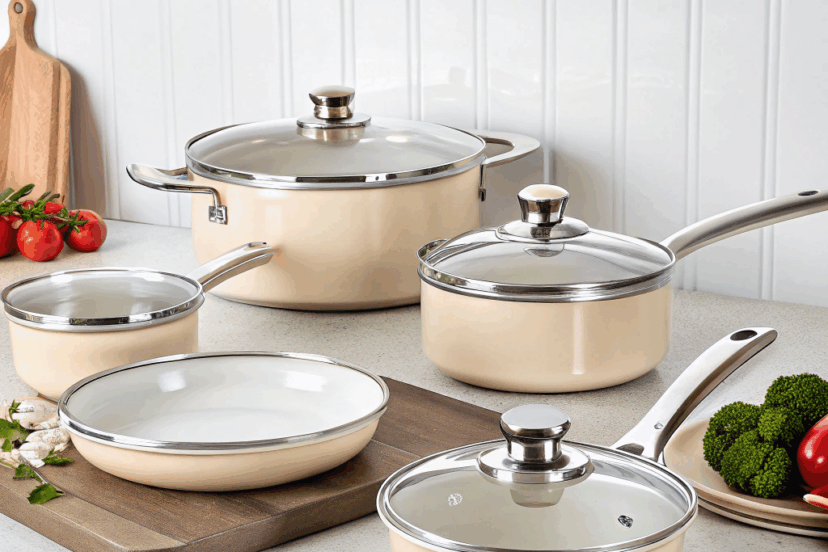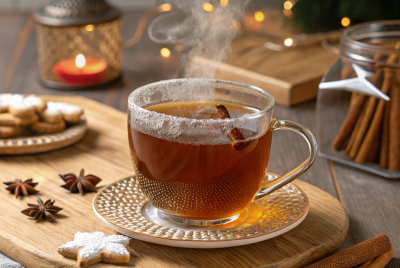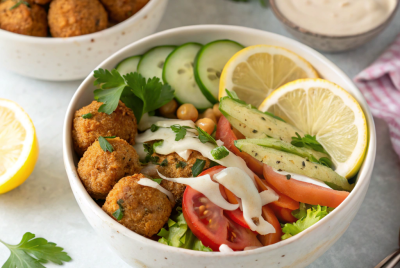Ceramic Non Stick Pan Guide 2025 For Healthier Cooking
If you’re tired of scraping eggs off traditional pans or concerned about potentially harmful chemicals in older non-stick cookware, you’ve come to the right place. As someone who spends countless hours in the kitchen testing cookware, I’ve developed quite the passion for finding the perfect tools that make cooking both healthier and more enjoyable.
Today, I want to share my expertise on ceramic non stick pans – a game-changer in modern kitchens that has transformed how I approach cooking. I’ve personally tested dozens of ceramic non stick pans over the years, and I’m excited to walk you through everything you need to know to make an informed decision for your kitchen.
Why I Switched to Ceramic Non Stick Pans
When I first heard about ceramic non stick pans several years ago, I was skeptical. Could they really perform as well as traditional non-stick cookware without the concerning chemicals? The answer, I quickly discovered, was a resounding yes!
Traditional non-stick pans often contained PFOA and PFAS (commonly known as “forever chemicals”), which raised health concerns when overheated. Ceramic non stick pans emerged as a revolutionary alternative, offering a safer cooking surface derived from natural materials like sand.
I made the switch about five years ago and haven’t looked back. Here’s why I love ceramic non stick pans:
- They’re free from potentially harmful chemicals like PFAS, PFOA, lead, and cadmium
- They provide excellent non-stick performance with proper care
- They heat up quickly and distribute heat evenly
- They require less oil for cooking, supporting healthier meal preparation
- They’re generally easier to clean than traditional cookware
Understanding Ceramic Coating Technology
Before diving into specific recommendations, it’s important to understand what makes a ceramic non stick pan special. Despite the name, these pans aren’t made entirely of ceramic – they typically feature an aluminum base with a ceramic-based coating applied to the cooking surface.
This ceramic coating is derived from silicon and oxygen (essentially sand-based), creating a slick, glass-like surface that food doesn’t easily stick to. Unlike traditional non-stick coatings, ceramic doesn’t release toxic fumes when overheated – something I personally value when cooking for my family.
The Science Behind Non-Stick Performance
The non-stick properties in ceramic pans come from the smooth, non-porous surface created during the manufacturing process. When properly cared for, this surface prevents food from bonding with the pan, allowing everything from eggs to pancakes to slide right off with minimal oil usage.
In my experience, a high-quality ceramic non stick pan can maintain its non-stick properties for 2-3 years with proper care, though this varies by brand and usage patterns. While this is typically shorter than traditional non-stick coatings, the health benefits make the trade-off worthwhile for me.
My Top 10 Ceramic Non Stick Pan Recommendations
After extensive testing, I’ve narrowed down the market to my top 10 ceramic non stick pans. Each offers unique features that might make it perfect for your specific cooking needs and budget. Let’s explore what makes each one special.
1. Blue Diamond Frying Pan 8″ Skillet
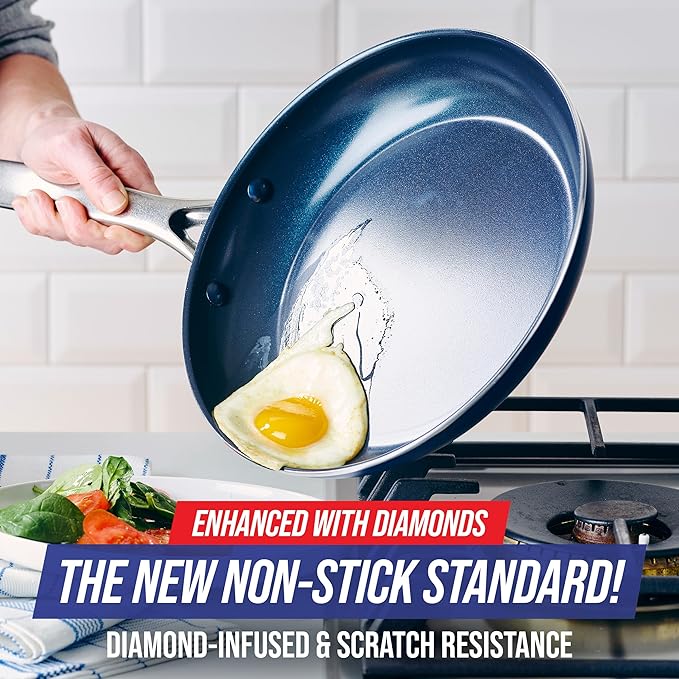 | The Blue Diamond 8″ Skillet has become my go-to for quick breakfast items like omelets and pancakes. What impressed me most about this pan is its diamond-infused coating, which genuinely delivers on its promise of enhanced durability and heat conduction. I’ve been using mine for over a year, and I’m still amazed at how quickly it heats up compared to other pans in my collection. The diamond particles in the ceramic coating aren’t just marketing hype – they make a noticeable difference in performance. I particularly appreciate the warp control base, which has kept the pan perfectly flat despite daily use. For those concerned about toxins, it’s completely PFAS and PFOA-free, giving me peace of mind when cooking at higher temperatures. The metal utensil safe surface has proven quite resilient, though I still primarily use silicone utensils out of habit. At around 600°F heat resistance, it’s also one of the most versatile ceramic non stick pans I’ve tested, easily transitioning from stovetop to oven for finishing dishes. |
2. CAROTE Non Stick Frying Pan 12 Inch
| When I need to cook for my entire family, I reach for my CAROTE 12-inch pan. Its generous size makes it perfect for larger meals, and the natural ceramic coating has maintained its non-stick properties impressively well over time. What sets this pan apart is its exceptional heat distribution. The aluminum core enveloped in ceramic coating creates a cooking surface that eliminates hot spots – something I’ve struggled with in other large pans. I’ve found the CAROTE particularly excellent for dishes that require consistent temperature, like crepes or delicate fish fillets. The stainless steel base makes it induction compatible, which was a must-have feature when I upgraded my kitchen. I also appreciate the brand’s eco-conscious approach, with the clean-up process requiring minimal water and detergent. After cooking, I often just wipe it with a paper towel, which aligns perfectly with my efforts to reduce water usage in the kitchen. | 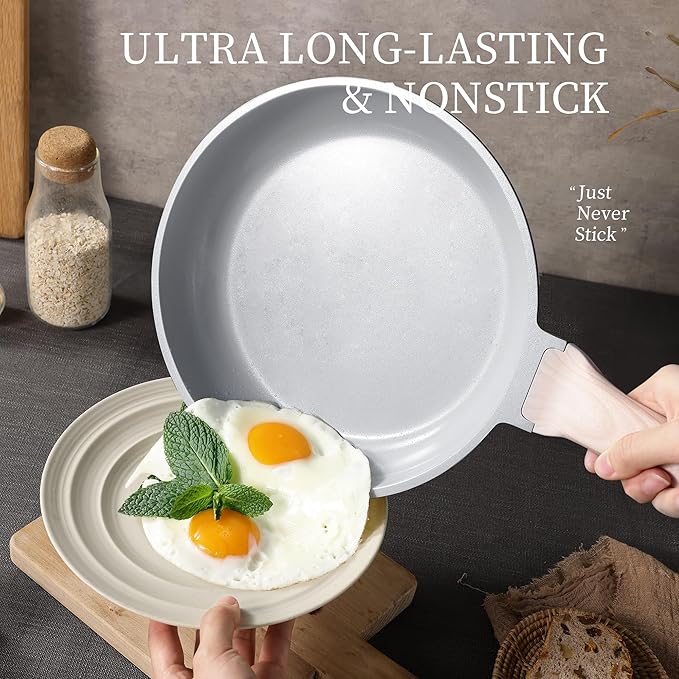 |
3. SENSARTE Nonstick Ceramic Frying Pan Skillet, 8-Inch
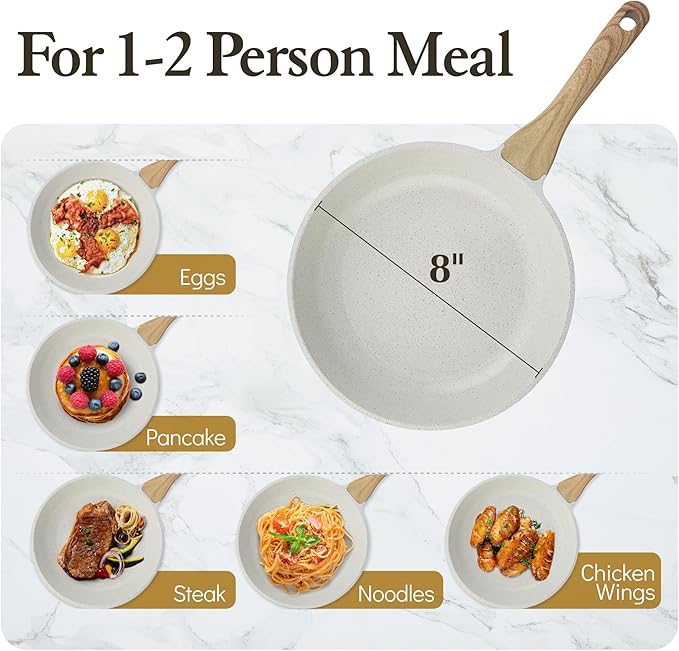 | For single servings and small side dishes, the SENSARTE 8-inch skillet has earned a permanent spot in my cookware rotation. This compact pan excels at quick-cooking tasks and takes up minimal storage space in my somewhat crowded cabinets. The non-stick performance of this pan is truly exceptional – I can cook eggs with absolutely no oil or butter if I choose, and they still slide right out. The white ceramic surface makes it easy to monitor food browning, which I’ve found particularly helpful when teaching my teenager how to cook. What I particularly love about this SENSARTE model is the ingenious woodgrain-design bakelite handle that stays remarkably cool during stovetop use. When I’m multitasking in the kitchen, not having to reach for a pot holder is a small but meaningful convenience. The induction compatibility was also a pleasant surprise at this price point, making it a versatile option for virtually any cooking setup. |
4. Gotham Steel Hammered Copper 14 Inch Non Stick Frying Pan with Lid
| When I’m entertaining guests, I bring out my Gotham Steel Hammered Copper pan – not just for its impressive cooking performance, but also because it’s simply gorgeous to look at. The hammered copper exterior adds a touch of elegance that makes serving directly from the pan a delight. Beyond aesthetics, this 14-inch pan delivers serious cooking power. The ceramic surface reinforced with titanium and diamonds creates a remarkably durable non-stick coating that has withstood countless meals. I especially value the extra-large cooking surface when preparing paella or large stir-fries – the generous 4-quart capacity easily serves my entire extended family. The inclusion of both a main handle and a helper handle makes maneuvering this larger pan much easier, even when full. The glass lid is another thoughtful addition that I use frequently for controlling moisture and heat during cooking. While it’s one of the pricier options on my list, the combination of performance, capacity, and visual appeal makes it well worth the investment for serious home cooks. | 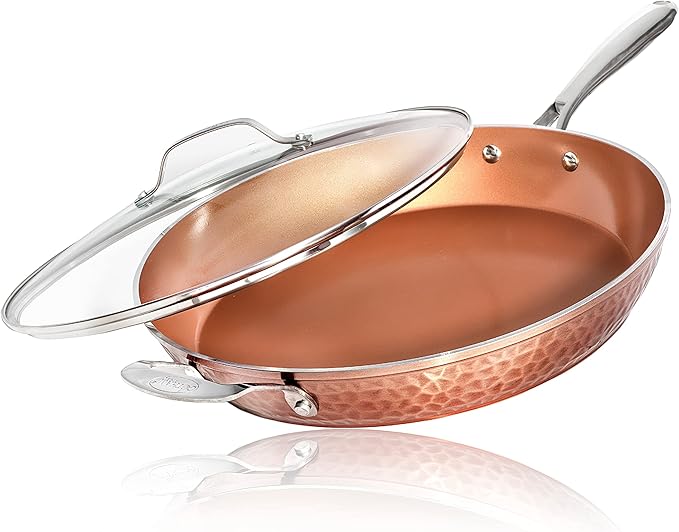 |
5. GreenLife 7″ & 10″ Ceramic Nonstick Frying Pan Set
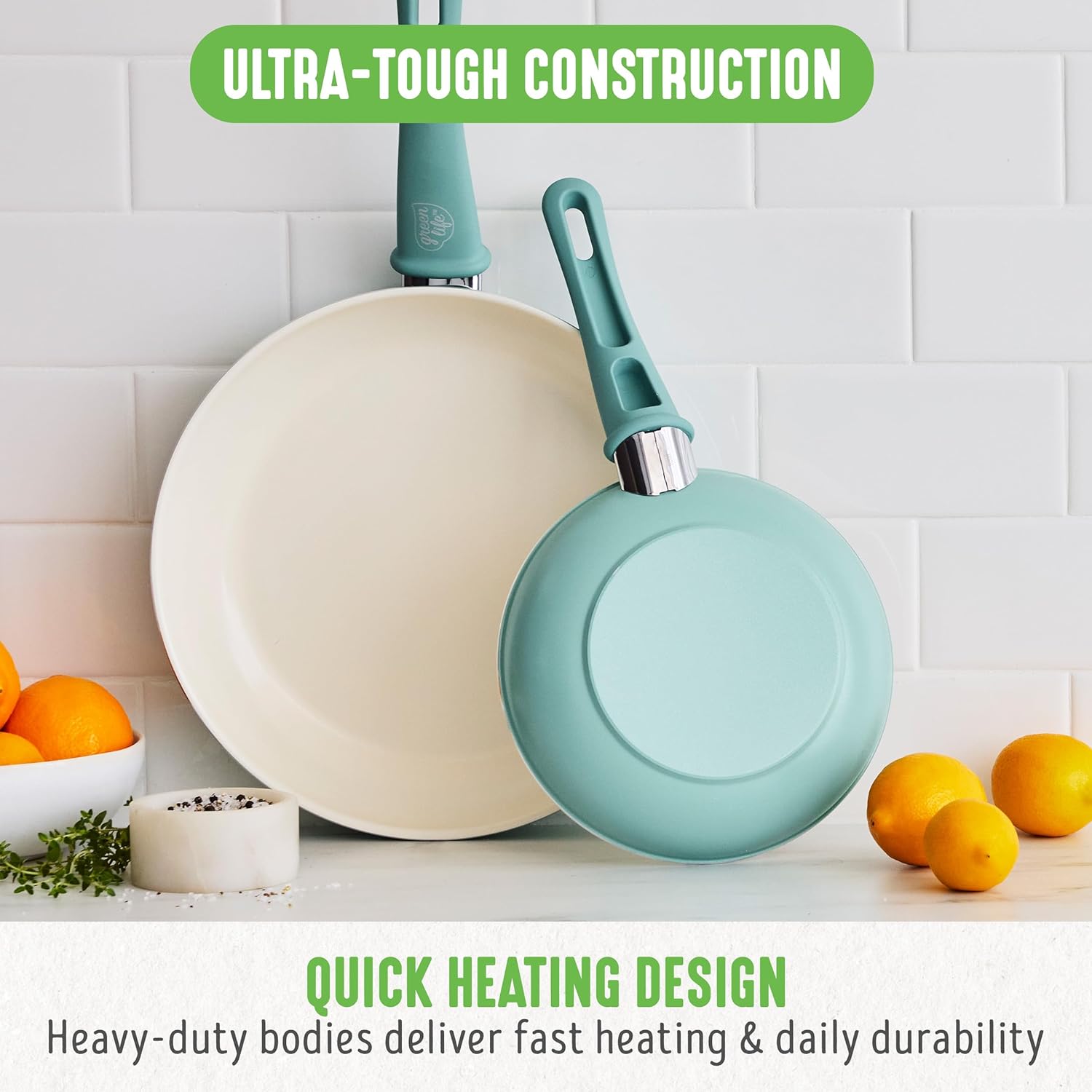 | The GreenLife pan set in vibrant turquoise brings both functionality and a pop of color to my kitchen. Having both a 7″ and 10″ option in matching design has proven incredibly practical for different cooking needs. These pans feature a sand-derived ceramic coating that performs beautifully while being completely free of PFAS and PFOA. What impressed me most about the GreenLife set is how lightweight the pans are without sacrificing durability. The wobble-free bases provide excellent stability, and I’ve found the heat distribution to be surprisingly even for pans at this price point. I particularly appreciate the brand’s commitment to sustainability, with the cookware vessels made from at least 65% recycled materials. The soft-grip handles are comfortable to hold and stay cool during cooking, though I’ve noticed they limit the oven-safe temperature to 350°F – lower than some other options on my list. For everyday stovetop cooking, however, these pans are a joy to use and impossibly easy to clean. |
6. SENSARTE Nonstick Ceramic Saute Pan 12-Inch with Lid
| For versatile one-pan meals, my SENSARTE 12-inch saute pan has become an essential kitchen tool. The deeper sides compared to a traditional frying pan make it perfect for dishes that start with sautéing and finish with liquid ingredients or sauces. The natural ceramic coating performs impressively, allowing for easy food release while being completely free from PFOA, PTFE, PFAS, lead, and cadmium. I’ve found this pan especially useful for dishes like chicken cacciatore, where I brown meat first and then simmer it in sauce – the food never sticks, and cleanup is remarkably simple. The thoughtful pour spout design has saved me from countless counter spills when transferring soups or sauces to serving dishes. The tempered glass lid allows me to monitor cooking progress without losing heat or moisture, and the bakelite handle stays comfortable to grip even during extended cooking sessions. For a pan that can handle so many different cooking techniques, the SENSARTE saute pan offers exceptional value. | 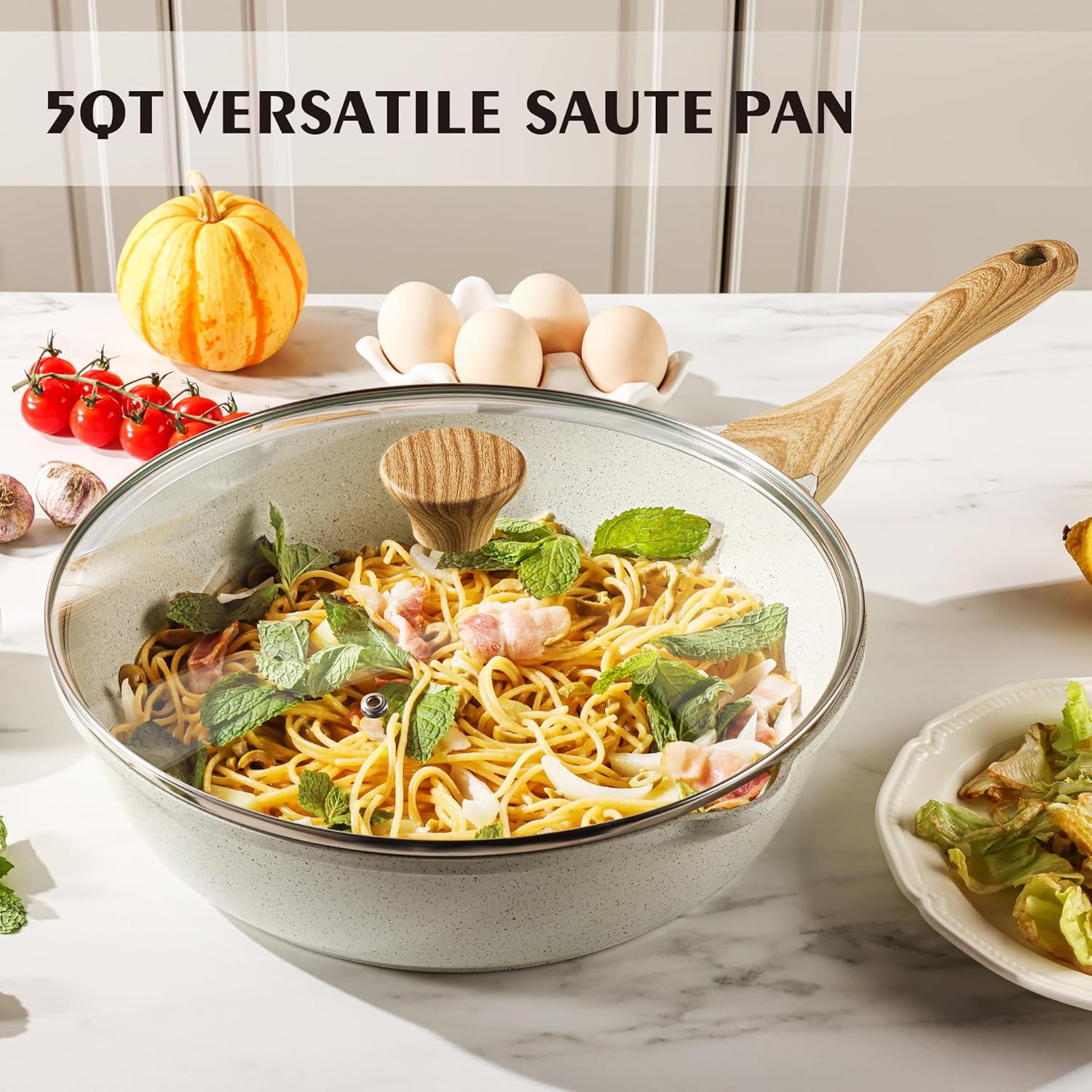 |
7. SENSARTE Nonstick Ceramic Frying Pan with Lid (Multiple Sizes)
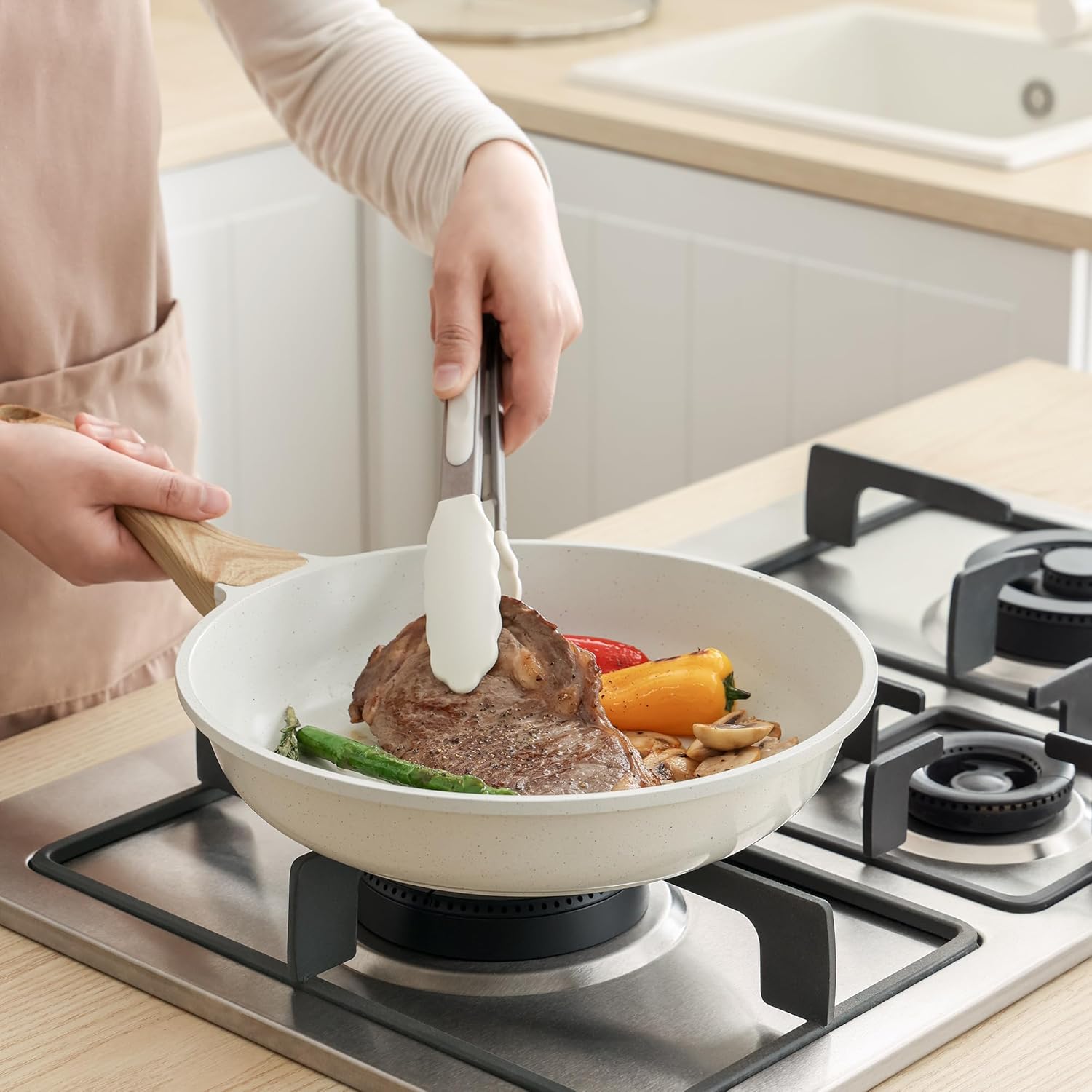 | The versatility of SENSARTE’s frying pan with lid in multiple size options impressed me so much that I ended up purchasing several sizes for different uses. Available in 8, 9.5, 10, 11, and 12.5-inch options, there’s truly a perfect size for every cooking need. The natural ceramic coating delivers consistent non-stick performance across all sizes, and I’ve found these pans particularly excellent for dishes that benefit from covered cooking. Pancakes and crepes slide effortlessly off the surface, making weekend breakfasts much more enjoyable. The heavy-duty cast aluminum construction prevents warping, which I’ve unfortunately experienced with lesser-quality pans. The induction-compatible base works seamlessly with all stovetops, making these pans an excellent choice for anyone who might change cooking setups in the future. The woodgrain bakelite handles maintain a comfortable cool touch during cooking, and the tempered glass lids have proven invaluable for containing splatter while still allowing me to monitor food. For everyday cooking versatility, this SENSARTE line offers outstanding quality at a reasonable price point. |
8. Vinchef Nonstick Deep Frying Pan Skillet with Lid, 11in/5Qt
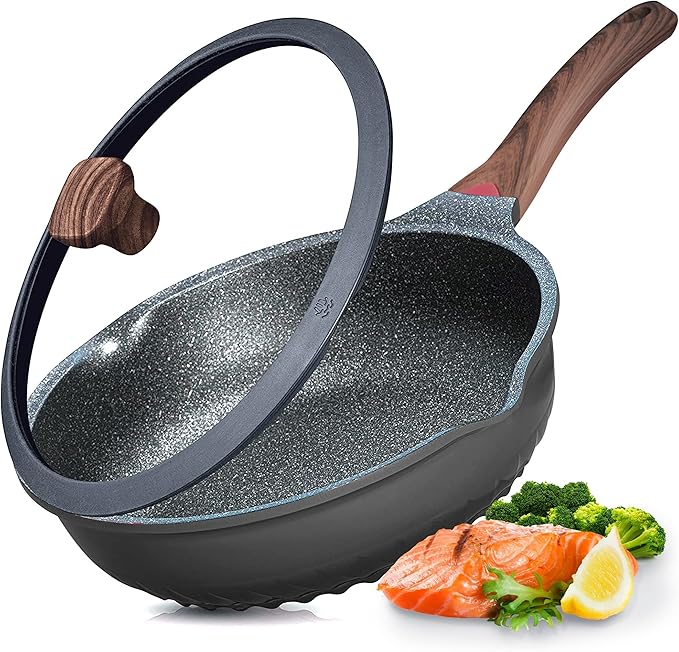 | The Vinchef deep frying pan with its generous 5-quart capacity has revolutionized my one-pot meal preparation. This pan strikes an ideal balance between a traditional frying pan and a deeper pot, making it incredibly versatile for various cooking techniques. What sets this pan apart is the German 3C+ ceramic coating technology, which delivers exceptional non-stick performance while remaining completely PFOA and APEO free. I’ve found this coating particularly durable compared to other ceramic surfaces I’ve tested. The innovative heat indicator in the handle changes color when the pan reaches the optimal cooking temperature of 300°F – a feature that has improved my cooking results by helping me add ingredients at precisely the right moment. The die-cast aluminum construction provides excellent heat distribution while keeping the pan lighter than cast iron alternatives. With its induction-compatible bottom, this pan works flawlessly on all stovetop types. The deeper walls and substantial capacity mean this single pan can replace several specialty pieces in your kitchen – I’ve used mine for everything from deep frying to slow-simmering stews with outstanding results. |
9. GreenPan Valencia Pro Hard Anodized 3 Piece Fry Pan Set
| For serious home cooks looking to invest in high-quality ceramic cookware, the GreenPan Valencia Pro set represents exceptional value. This award-winning set includes 8″, 9.5″, and 11″ frying pans – covering virtually all everyday cooking needs. The Duoforged hard anodized bodies provide extraordinary durability, with pre-treatment before anodization that significantly enhances scratch resistance. In my experience, these pans have maintained their appearance and performance better than any other ceramic cookware I’ve tested. The diamond-infused ceramic non-stick coating delivers remarkable food release properties while remaining completely free of PFAS, PFOA, lead, and cadmium. What truly distinguishes this set is the Magneto induction bases, which are specifically optimized for all cooking surfaces, including induction. I’ve noticed particularly even heating across these pans, with no hot spots even when cooking delicate items like crepes or fish. While the Valencia Pro set represents a higher investment than some options on my list, the performance justification is clear – these pans have won recognition from America’s Test Kitchen as the best ceramic non-stick frypans and received the 2023 Good Housekeeping Sustainable Innovation Award. | 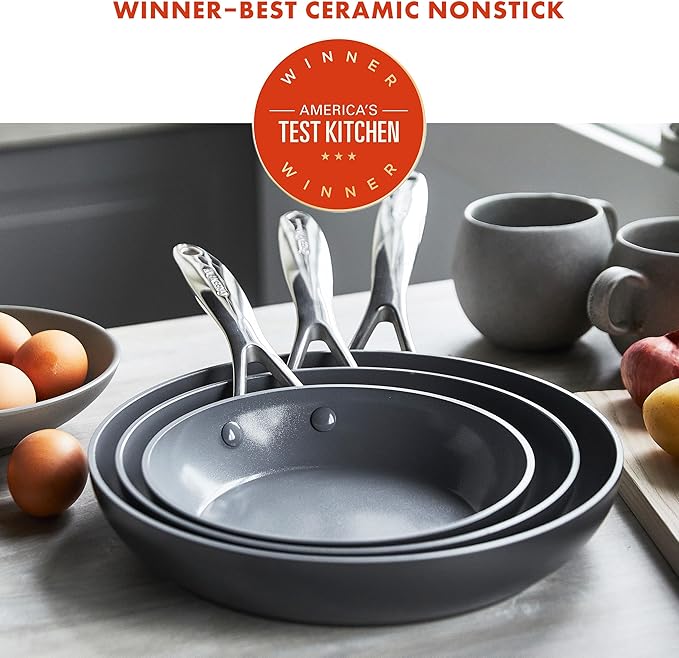 |
10. GreenLife Soft Grip Healthy Ceramic Nonstick 16 Piece Kitchen Set
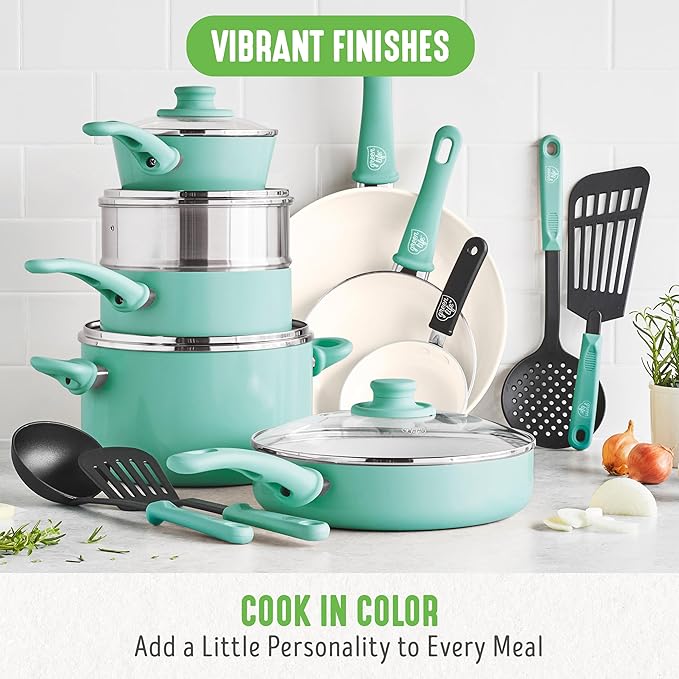 | When I was setting up my first apartment after college, I chose the GreenLife 16-piece set to establish a complete kitchen in one purchase – and years later, many pieces are still in regular rotation. This comprehensive set includes 4″ mini frying pan, 7″ and 9.5″ frying pans, 1QT and 2QT saucepans with lids, 5QT stock pot with lid, 2.5QT sauté pan with lid, a stainless steel steamer, and four kitchen utensils. The sand-derived ceramic non-stick coating performs admirably across all pieces while remaining free of PFAS, PFOA, lead, and cadmium. I particularly appreciate the soft-grip handles, which provide comfortable control even when handling heavier items like the stock pot. The vibrant turquoise color has maintained its appeal over time, making this set both functional and visually pleasing. Each piece features a wobble-free base for stability and even heating, with performance suitable for all stovetops except induction. The oven-safe rating of 350°F isn’t the highest on my list but covers most everyday cooking needs. For those setting up a new kitchen or replacing multiple worn-out pieces simultaneously, this GreenLife set offers exceptional value and consistent performance across all included items. |
How to Choose the Right Ceramic Non Stick Pan
After testing so many options, I’ve developed a framework for evaluating ceramic non stick pans that might help you make the best choice for your specific needs. Here are the key factors I consider:
Size and Shape Considerations
The right size pan depends entirely on your typical cooking needs:
- 8-inch pans: Perfect for cooking for one, preparing side dishes, or making omelets
- 10-inch pans: The versatile standard for most everyday cooking for 2-3 people
- 12-inch pans and larger: Ideal for family meals or when you entertain regularly
Beyond diameter, consider depth as well. Deep sides are excellent for dishes with sauces or multiple ingredients, while shallower pans excel at tasks requiring easy access with spatulas, like flipping pancakes or searing protein.
I recommend having at least two different sizes in your kitchen for maximum versatility.
Handle Design and Comfort
Never underestimate the importance of a comfortable handle! In my experience, the best ceramic non stick pans feature:
- Ergonomic designs that fit comfortably in your hand
- Stay-cool materials like bakelite or silicone-wrapped handles
- Secure attachment methods (riveted handles tend to last longest)
- Helper handles on larger pans for safe maneuvering when full
I’ve learned through several unfortunate accidents that a poor handle design can turn an otherwise excellent pan into a safety hazard. Take the time to evaluate this crucial feature.
Durability Factors
While all ceramic coatings will eventually wear down, certain construction features can significantly extend a pan’s lifespan:
- Base construction: Look for forged or hard-anodized aluminum bases to prevent warping
- Reinforced coating: Diamond or titanium-infused ceramic coatings typically last longer
- Rim design: Sealed rims help prevent water intrusion that can degrade the coating over time
In my collection, the pans with reinforced coatings have consistently outlasted their standard counterparts, often by a year or more of regular use.
Compatibility With Your Stovetop
Always verify that your chosen pan works with your cooking surface:
- Induction stovetops require pans with magnetic bases
- Glass or ceramic cooktops benefit from perfectly flat, heavy-bottomed pans
- Gas ranges work with most pans but perform best with those designed for even heat distribution
I learned this lesson the hard way after purchasing a beautiful ceramic non stick pan that was incompatible with my induction stovetop – check specifications carefully before buying!
Caring for Your Ceramic Non Stick Pan
The biggest factor determining the lifespan of your ceramic non stick pan is how you care for it. I’ve managed to extend the life of my favorite pans significantly by following these practices:
Cooking Temperature Best Practices
Ceramic coatings can withstand higher temperatures than traditional non-stick surfaces, but they still have limits:
- Stick to low to medium heat settings for everyday cooking
- Avoid empty-pan preheating for extended periods
- If you need high heat for searing, do so sparingly
- Allow pans to cool naturally rather than shocking with cold water
I’ve found that gradual temperature changes and avoiding extreme heat help preserve the non-stick properties significantly longer.
Cleaning and Maintenance Tips
Proper cleaning is essential for ceramic non stick pan longevity:
- Allow the pan to cool before cleaning
- Hand wash with mild dish soap and a soft cloth or sponge
- For stubborn residue, soak briefly in warm, soapy water
- Never use abrasive cleaners or scrubbers
- Dry thoroughly before storing
While many ceramic pans claim to be dishwasher safe, I’ve noticed that hand washing extends their lifespan considerably. The harsh detergents and high temperatures in dishwashers can gradually degrade the ceramic coating.
Utensil Selection Importance
The right tools make a tremendous difference in preserving your pan’s surface:
- Silicone, wood, or nylon utensils are safest for all ceramic non stick pans
- Even with “metal utensil safe” claims, I’ve found that softer tools extend pan life
- Avoid cutting food directly in the pan, regardless of manufacturer claims
- Use non-abrasive cleaning tools like soft sponges or cloths
I keep a special set of silicone utensils specifically for use with my ceramic non stick cookware, which has helped maintain their performance over time.
Why Ceramic Non Stick Pans Are Worth the Investment
After years of cooking with various types of cookware, I remain convinced that ceramic non stick pans offer the best balance of performance, health benefits, and value. Here’s why I continue to recommend them:
Health Benefits Over Traditional Non-Stick
The primary advantage of ceramic non stick pans is their safety profile:
- No PFAS or PFOA chemicals that can off-gas at high temperatures
- No risk of these “forever chemicals” flaking into food over time
- Less oil required for cooking, supporting heart-healthy meal preparation
- No toxic fumes even if accidentally overheated
For my family, these health benefits alone justify choosing ceramic over traditional non-stick options.
Environmental Considerations
Many ceramic non stick brands are making significant strides in sustainability:
- Recycled materials in construction (like GreenLife’s 65% recycled content)
- More eco-friendly manufacturing processes
- Longer lifespan than earlier ceramic technologies
- Less water needed for cleaning
As someone who tries to make environmentally conscious purchasing decisions, I appreciate these efforts toward sustainability in cookware manufacturing.
Cost-Value Analysis
When evaluating the investment in ceramic non stick pans, consider:
- Initial cost vs. expected lifespan (typically 2-3 years with proper care)
- Reduced need for cooking oils and fats
- Energy efficiency due to excellent heat conductivity
- Versatility across cooking techniques
While quality ceramic non stick pans may cost more initially than basic cookware, their performance and health benefits provide excellent value over their useful life. I’ve found the mid-range options ($40-80 per pan) typically offer the best balance of quality and affordability.
Conclusion: Choosing the Right Ceramic Non Stick Pan for Your Kitchen
After testing dozens of ceramic non stick pans and writing about my top 10 recommendations, I’m confident there’s a perfect option for every cook and kitchen. Whether you prioritize durability, environmental concerns, or specific cooking performance, the ceramic non stick category offers tremendous variety.
For most home cooks, I recommend starting with a 10-inch ceramic non stick frying pan from a reputable brand like GreenPan, Blue Diamond, or SENSARTE. This versatile size handles most everyday cooking tasks beautifully. As you discover how much you enjoy cooking with ceramic non stick surfaces, you can expand your collection with specialized pieces that match your cooking style.
Remember that even the best ceramic non stick pans require proper care to maximize their lifespan. By following the temperature, cleaning, and utensil guidelines I’ve shared, you’ll get the most value from your investment while enjoying healthier, easier cooking.
I hope my experiences and recommendations help you find the perfect ceramic non stick pan for your needs. Happy cooking!
Frequently Asked Questions About Ceramic Non Stick Pans
1. How long do ceramic non stick pans typically last?
With proper care and maintenance, a quality ceramic non stick pan typically lasts 2-3 years of regular use before the non-stick properties begin to diminish significantly. I’ve found that higher-end models with reinforced coatings (like diamond-infused ceramics) can extend this lifespan by an additional year or more. To maximize longevity, avoid high heat, use appropriate utensils, and hand wash gently.
2. Can ceramic non stick pans go in the oven?
Most ceramic non stick pans are oven-safe, but temperature limits vary significantly between brands and handle materials. In my experience, pans with metal handles typically offer the highest heat resistance (up to 600°F in some cases), while those with bakelite or silicone handles usually max out around 350-400°F. Always check the manufacturer’s specifications for your specific pan before using it in the oven to prevent damage or safety hazards.
3. Why has my ceramic non stick pan lost its non-stick properties?
Several factors can cause ceramic non stick pans to lose their effectiveness prematurely. The most common culprits I’ve encountered include: regular use of high heat that gradually degrades the coating, cleaning with abrasive scrubbers or harsh detergents, using metal utensils that scratch the surface, and oil polymerization (a thin, amber layer of baked-on oil that builds up over time). To restore minor loss of non-stick properties, try a deep cleaning with baking soda paste, but be aware that significant coating degradation is usually permanent.
4. Are ceramic non stick pans truly safer than traditional non-stick cookware?
Based on current scientific understanding, ceramic non stick pans are generally considered safer than traditional PTFE-based non-stick cookware (especially older generations that contained PFOA). Ceramic coatings are typically made from silicon and oxygen derivatives that don’t release toxic fumes when overheated and don’t contain the “forever chemicals” that have raised health concerns. However, quality matters significantly – I always recommend purchasing from reputable brands that provide clear information about their materials and manufacturing processes.
5. Can I use oil sprays with ceramic non stick pans?
I’ve learned through experience that commercial aerosol cooking sprays are best avoided with ceramic non stick pans. These sprays often contain lecithin and other additives that can create a sticky residue on the ceramic surface that’s difficult to remove and progressively damages the non-stick properties. Instead, I recommend applying a small amount of high-quality oil using a paper towel or silicone brush before heating the pan, or investing in a refillable oil mister that dispenses pure oil without additives.

